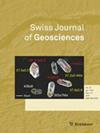印度西北部米亚山谷高喜马拉雅结晶的前喜马拉雅变质作用证据
IF 2.6
2区 地球科学
Q3 GEOSCIENCES, MULTIDISCIPLINARY
引用次数: 0
摘要
大多数构造、变质和年代学资料表明,喜马拉雅本质上是与新生代印度-亚洲碰撞有关的单一造山旋回的结果。因此,喜马拉雅山脉的变质组合和构造构造被系统地认为是碰撞后的地质记录。然而,在过去的几十年里,一些主张大陆碰撞之前的地质事件的观察结果在文献中越来越频繁地出现。然而,尽管这些论点中的一些被彻底地记录下来,但在绘制喜马拉雅山脉构造-变质演化的模型的构建中,它们被过度地忽略了。然而,前喜马拉雅历史的出现将对喜马拉雅构造的经典模型产生相当大的影响。喜马偕尔邦上拉胡尔地区密亚尔河谷绿片岩相石榴石中星沸石晶体包裹体的新发现印度西北部)重新引起了关于前喜马拉雅变质作用存在的争论。绿片岩相石榴石中含有高温星沸石,表明高喜马拉雅结晶岩经历了角闪岩相变质作用,这一变质作用先于该地区主要的喜马拉雅绿片岩相变质作用。结合相岩学、微构造学研究和已有的年代学资料推断,所含锆石的结晶作用早于喜马拉雅石榴石的生长。这些原始资料为长期以来关于前喜马拉雅造山旋回存在的争论带来了新的论据。他们得出的结论是,锆石的生长早于印度和亚洲大陆之间的碰撞,反映了属于前喜马拉雅造山旋回的变质事件。本文章由计算机程序翻译,如有差异,请以英文原文为准。
Evidence for a pre-Himalayan metamorphism in the High Himalayan Crystalline of the Miyar Valley (NW India)
Abstract Most of the tectonic, metamorphic and geochronological data suggest that the Himalaya is essentially the consequence of a single orogenic cycle associated with the India-Asia collision during the Cenozoic era. Therefore, metamorphic assemblages and tectonic structures across the Himalayan range are systematically considered as post-collisional geological records. However, over the last decades, several observations arguing for geological events predating the continental collision have become increasingly recurrent in the literature. Nevertheless, although some of these arguments are thoroughly documented, they are unduly ignored in the construction of models drawing the tectono-metamorphic evolution of the Himalayan range. Yet, the occurrence of a pre-Himalayan history would have considerable consequences on the classical models for the building of the Himalaya. The recent discovery of inclusions of staurolite crystals in greenschist facies garnets from the Miyar Valley in Upper Lahul region (Himachal Pradesh; NW India) revives the debate on the existence of a pre-Himalayan metamorphism. Indeed, the occurrence of high-temperature staurolites included in greenschist facies garnets suggests that the High Himalayan Crystalline rocks experienced an amphibolite facies metamorphism prior the predominant Himalayan greenschist facies metamorphism observed in this part of the range. In this study, phase petrology, microtectonic investigations combined with preexisting geochronological data infer that the crystallization of the included staurolite predates the growth of Himalayan garnets. These original data bring new arguments to bear on the long lasting debate of the existence of a Pre-Himalayan orogenic cycle. They lead to the conclusion that the growth of staurolite predates the continental collision between India and Asia and reflects a metamorphic event that belongs to a pre-Himalaya orogenic cycle.
求助全文
通过发布文献求助,成功后即可免费获取论文全文。
去求助
来源期刊

Swiss Journal of Geosciences
地学-地质学
CiteScore
4.50
自引率
12.90%
发文量
21
审稿时长
>12 weeks
期刊介绍:
The Swiss Journal of Geosciences publishes original research and review articles, with a particular focus on the evolution of the Tethys realm and the Alpine/Himalayan orogen. By consolidating the former Eclogae Geologicae Helvetiae and Swiss Bulletin of Mineralogy and Petrology, this international journal covers all disciplines of the solid Earth Sciences, including their practical applications.
The journal gives preference to articles that are of wide interest to the international research community, while at the same time recognising the importance of documenting high-quality geoscientific data in a regional context, including the occasional publication of maps.
 求助内容:
求助内容: 应助结果提醒方式:
应助结果提醒方式:


